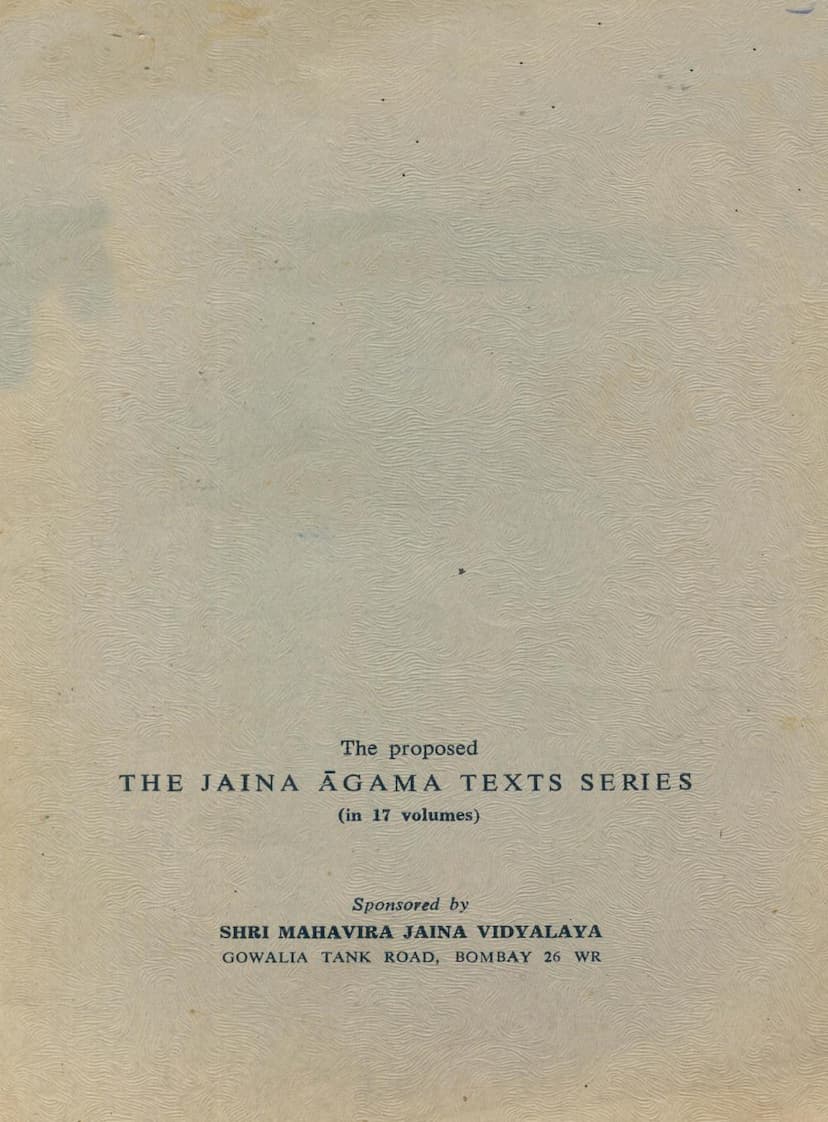Nandisuttam
Added to library: September 2, 2025

Summary
Here's a comprehensive summary of the provided pages of the Nandisuttam, focusing on the introductory and textual content presented:
Overall Context and Project:
The provided pages are from the Nandisuttam, part of "THE JAINA AGAMA TEXTS SERIES" being published by Shri Mahavira Jaina Vidyalaya, Bombay. This ambitious project, launched in 1964, aims to critically edit and publish the entire Jaina Agama texts in 17 volumes over ten years. The series is a significant undertaking to address the scholarly void in the critical study and publication of Prakrit literature, which is considered essential for a complete understanding of Indian culture. The project is sponsored by Shri Mahavira Jaina Vidyalaya and guided by eminent scholars like Muni Shri Punyavijayaji and Pandit Dalsukh Malvania. The publication aims for high quality with durable binding and specially manufactured paper.
The Nandisuttam and its Place in the Series:
The Nandisuttam is presented as Volume I of the Jaina Agama Texts Series, alongside the Anuyogadvarasutra. This indicates its foundational importance within the Jaina scriptural canon.
Content of the Provided Pages:
The pages offer a glimpse into the Nandisuttam itself, including:
-
Invocation and Praises: The text begins with a traditional invocation ("णमो त्यु णं समणस्स भगवओ महइ-महावीर-चद्धमाणसामिस्स ॥ णमो अणुओगधराणं थेराणं") and salutations to Lord Mahavir and the Anuyogadharas (those who carry the Agamas). This is followed by a series of verses (Sutras 1-12) offering praise ("थुई") to Lord Mahavir ("तित्थयरमहावीरत्थुई") and the Jain Sangha ("संघत्थुई"). These verses eloquently describe the Sangha's virtues, its role in upholding righteous conduct, and its significance in the spiritual journey.
-
Genealogies of Teachers (Theravali): A significant portion of the text is dedicated to the Theravali (Sutras 23-43), which meticulously lists and praises the lineage of important Jain monks and scholars. This section highlights the continuity of Jain teachings and acknowledges the contributions of various Acharyas who preserved and propagated the Agamic knowledge. The names of prominent figures like Subhamma, Jambunama, Kashava, Pabhav, Sajjambhav, Bhadrabahu, Sthulabhadra, Gotama, and Nagajuna are mentioned, underscoring their importance in the tradition. The text also mentions the disciples of some of these great teachers.
-
Knowledge (Jnana) and its Classifications: The text then moves into a detailed exposition of Jnana (knowledge) and its various types (Sutras 68-69). It classifies knowledge into five types:
- Abhinibodhika Jnana (sensory and mental knowledge)
- Shuta Jnana (scriptural knowledge)
- Avadhi Jnana (clairvoyance)
- Manahparyaya Jnana (telepathy)
- Kevala Jnana (omniscience)
-
Sensory and Non-Sensory Knowledge: Knowledge is further divided into Pratyaksha (direct perception) and Paroksha (indirect perception). Direct perception is then categorized into sensory (eye, ear, nose, tongue, touch) and non-sensory knowledge.
-
Detailed Explanation of Avadhi Jnana: A substantial part of the provided text (Sutras 13-29) is dedicated to the detailed explanation of Avadhi Jnana. It outlines:
- Source of Avadhi Jnana: It can arise from innate disposition (born with it) or through the shedding of karmic obstructions (kshāyopashama). Gods and hell-dwellers possess it by nature, while humans and five-sensed animals acquire it through karmic resolution.
- Types of Avadhi Jnana: It is classified into six types:
- Anugāmī (Moving): This type of Avadhi Jnana can perceive objects in front, along the path, or to the side. It is described with vivid analogies using objects like a torch, a gem, or a lamp, demonstrating how the scope of perception can be forward, along a path, or sideways.
- Aṇugāmi (Non-moving): This type of Avadhi Jnana is limited to the immediate vicinity of its origin and cannot extend beyond it.
- Vardhamāna (Increasing): This Avadhi Jnana grows with virtuous activities and mental states. The text provides detailed measures of spatial and temporal extent for this increasing knowledge.
- Hāyamāna (Decreasing): This Avadhi Jnana diminishes with less virtuous activities and mental states.
- Prativāyī (Fading): This type of Avadhi Jnana fades and can be perceived within specific, defined limits, from a very small fraction of an inch to the entire universe.
- Aprativāyī (Non-fading): This is the highest form of Avadhi Jnana, which can perceive even a single point in the non-spatial realm (aloka).
- Scope of Avadhi Jnana: The text specifies the scope in terms of substance (dravya), space (kṣetra), time (kāla), and mode (bhāva), detailing the minimum and maximum limits of perception for each.
-
Explanation of Manahparyaya Jnana: The text then introduces Manahparyaya Jnana (Sutras 30-33), which is the knowledge of the thoughts of others. It elaborately discusses:
- Who possesses it: It is possessed by humans, not non-humans.
- Specific types of humans: It is acquired by humans born in a womb (not spontaneously generated beings), specifically those born in karma-bhūmi (fertile lands where religious practice is possible), and among them, those with a lifespan of a finite duration (not infinite). Further, it's held by those with perfect right faith (samyak-darśana) and, more specifically, by those who are vigilant and practice right conduct (samyak-caritra) with utmost diligence.
- Two types of Manahparyaya Jnana: It is divided into Rjumati (simple, straightforward thought-reading) and Vimalamati (complex, analytical thought-reading).
- Scope of Manahparyaya Jnana: Similar to Avadhi Jnana, its scope is defined in terms of substance, space, time, and mode.
Scholarly Significance:
The project's aim to publish critically edited Jaina Agama Texts underscores the importance of preserving and making accessible these ancient scriptures. The inclusion of Nandisuttam in the initial volumes signifies its central role in Jaina philosophy and epistemology, particularly in its detailed classification and description of knowledge. The series also represents a significant effort to revive and promote the study of Prakrit literature.
In essence, these pages showcase a monumental scholarly endeavor to present the Nandisuttam with critical apparatus, starting with veneration for the Jain tradition and then delving into the intricate philosophical concepts of knowledge as expounded in this key Jaina scripture.